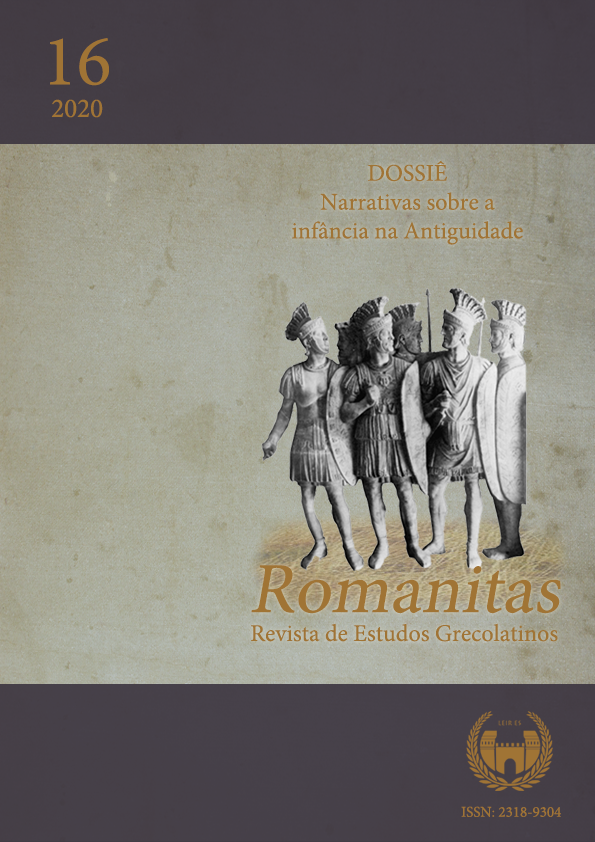A juventude dos imperadores romanos Caracala e Geta: questões políticas, familiares e numismáticas
DOI:
https://doi.org/10.17648/rom.v0i16.31910Palabras clave:
Caracala, Geta, Família, Juventude, MoedasResumen
Nos documentos textuais latinos, produzidos nos séculos III e IV, temos poucas informações sobre a juventude dos filhos e herdeiros do Imperador Romano Lúcio Septímio Severo com Júlia Domna, Caracala e Geta. Eles só passam a interessar aos autores quando ascendem ao comando imperial em 211, após a morte do pai, na Bretanha, quando já têm respectivamente 23 e 22 anos de vida. Contudo, no afã de divulgar a união familiar e a continuidade da gens Septímia no poder, foram cunhadas várias moedas com a imagem dos herdeiros ainda muito jovens e imberbes. Neste artigo, buscamos analisar o uso político da coesão familiar como matriz da governabilidade severiana, a partir da emissão de mensagens via suportes textuais e numismáticos, nos quais identificamos representações dos ainda jovens Caracala e Geta.
Descargas
Citas
Documentação textual
AAVV. Biógrafos e panegiristas latinos. Traducción de Luis Escolar Barreño et al. Madrid: Aguilar, 1969.
CASSIO DIONE. Storia Romana. Traduzione di Alessandro Stroppa. Milano: BUR, 1998.
CORNELIO NEPOTE. Vidas. Traducción de Manuel Segura Moreno. Madrid: Gredos, 1985.
DIO CASSIUS. Roman History. Translated by Earnest Cary. London: William Heinemann, 1961.
EPITOME DE CAESARIBUS. Traduit par M. N. A. Dubois. Paris: C.L.F. Panckoucke, 1846.
ERODIANO. Storia dell’Impero Romano dopo Marco Aurelio. Traduzione di Filippo Càssola. Firenze: Sansoni, 1967.
EUTROPE. Abrègé de l’Histoire Romaine. Traduit par Maurice Rat. Paris: Garnier, 1990.
EUTRÓPIO. Compêndio de História Romana. Tradução de Padre João Ravizza. Niterói: Escolas Professoras Salesianas, 1931.
EUTRÓPIO. Breviário. Traducción de Emma Falque. Madrid: Gredos, 1999.
HERODIANO. Historia del Imperio Romano después de Marco Aurélio. Traducción de Juan J. Torres Esbarranch. Madrid: Gredos, 1985.
HÉRODIEN. Histoire de l’Empire Romain après Marc-Aurèle. Traduit par Denis Roques. Paris: Les Belles Lettres, 1990.
SEXTUS AURELIUS VICTOR. Histoire des Césars. Traduit par Pierre Dufraigne. Paris: Les Belles Lettres, 1975.
HÉRODIEN. Libro de los Césares. Traducción de Emma Falque. Madrid: Gredos, 1999.
THE SCRIPTORES HISTORIAE AUGUSTAE. Translated by David Magie. London: William Heinemann, 1953.
Documentação numismática
MATTINGLY, H.; SYDENHAM, E. A. (ed.). The Roman imperial coinage. London: Spink and Son, 1936. v. 4.
MATTINGLY, H.; SYDENHAM, E. A. (ed.). Coins of the Roman Empire in the British Museum. London: British Museum, 1950. v. 5.
Obras de apoio
ARIÈS, Ph. História social da infância e da família. Rio de Janeiro: Zahar, 1981.
BIRLEY, A. Septimius Severus: the African emperor. London: Routledge, 1999.
BRAVO, G.; GONZÁLEZ SALINERO, R. (eds.). Propaganda y persuasión en el mundo romano. Salamanca: Signifer, 2011.
CALDERINI, A. I Severi. Bologna: Licinio Cappelli, 1949.
CAPPELLI, R. Profili Imperiali Romani. Milano: Mursia, 1963.
CASINOS MORA, F. J. La noción romana de auctoritas y la responsabilidad por auctoritas. Granada: Comares, 2000.
CAZENAVE, M.; AUGUET, R. Os imperadores loucos. Sintra: Inquérito, 1995.
COULANGES, F. de. A cidade antiga. Rio de Janeiro: Zahar, 1982.
FRASCHETTI, A. O mundo romano. In: LEVI, G.; SCHMITT, J.-Cl. (org.). História dos jovens. São Paulo: Companhia das Letras, 1996, p. 59-96. v. 1.
FRASCHETTI, A. Rome et le prince. Paris: Belin, 1994.
GONÇALVES, A. T. M. Lúcio Septímio Severo: a força de um norte-africano no Império Romano. In: REDE, M. (org.). Vidas Antigas: ensaios biográficos da Antiguidade. São Paulo: Intermeios, 2019, p. 159-190.
LENDON, J. E. Empire of honour. Oxford: University Press, 1997.
LINDSAY, H. Adoption in the Roman World. Cambridge: University Press, 2009.
MILLAR, F. The emperor in the Roman World. London: Duckworth, 1992.
MILLAR, F. A study of Cassius Dio. Oxford: Clarendon Press, 1964.
NODELMAN, S. Severan imperial portraiture. Yale University, unpublished.
SARTRE, M. Virilidades gregas. In: CORBIN, A.; COURTINE, J.; VIGARELLO, G. (dir.). História da virilidade. Petrópolis: Vozes, 2013, p.17-70. v. 1.
SCHNAPP, A. A imagem dos jovens na cidade grega. In: LEVI, G.; SCHMITT, J.-C. (org.). História dos jovens. São Paulo: Companhia das Letras, 1996, p.19-58. v. 1.
SKINNER, M. B. Sexuality in Greek and Roman Culture. London: Blackwell, 2006.
TALBERT, R. J. A. The Senate of imperial Rome. Princeton: Princeton University Press, 1984.
THUILLIER, J.-P. Virilidades romanas: vir, virilitas, virtus. In: CORBIN, A.; COURTINE, J.; VIGARELLO, G. (dir.). História da virilidade. Petrópolis: Vozes, 2013, p.71-124. v. 1.
VARNER, E. R. Mutilation and transformation: damnatio memoriae and Roman imperial portraiture. Boston: Brill, 2004.
VEYNE, P. O Império Romano. In: ARIÈS, Ph.; DUBY, G. (dir.). História da vida privada. São Paulo: Companhia das Letras, 1990, p.19-224. v. 1.
Descargas
Publicado
Cómo citar
Número
Sección
Licencia
Derechos de autor 2021 Ana Teresa Marques Gonçalves

Esta obra está bajo una licencia internacional Creative Commons Atribución-NoComercial-SinDerivadas 4.0.
a. Los autores conservan los derechos de autor y otorgan a la revista el derecho de publicar primero.
c. Los autores están autorizados a asumir contratos adicionales por separado, para la distribución no exclusiva de la versión del trabajo publicado en esta revista (por ejemplo, publicación en repositorio institucional o como capítulo de libro), con reconocimiento de autoría y publicación inicial en esta revista.
c. Se permite y se estimula a los autores a publicar y distribuir su trabajo online (por ejemplo, en repositorios institucionales o en su página personal) después de la primera publicación de la revista, con los debidos créditos. Atribución-No Comercial-No Derivadas
d. Los textos de la revista tienen licencia bajo CC BY 4.0 Deed Atribución 4.0 Internacional (CC BY).




























